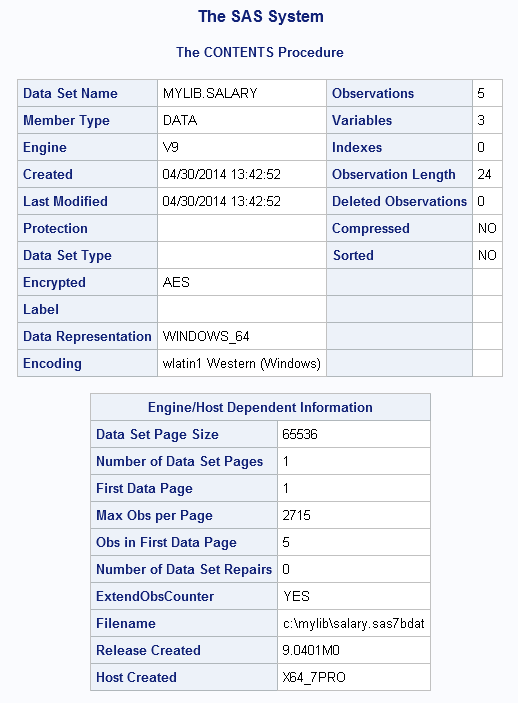ENCRYPT= Data Set Option
Specifies whether to encrypt an output SAS data set.
| Valid in: | DATA step and PROC steps |
| Category: | Data Set Control |
| Default: | ENCRYPT=NO |
| Restriction: | Use with output data sets only. |
Syntax
Syntax Description
AES
encrypts the file by using the AES (Advanced Encryption Standard) algorithm. AES provides enhanced encryption by using SAS/SECURE software, which is included with Base SAS software. You must specify the ENCRYPTKEY= data set option when you are using ENCRYPT=AES. For more information, see ENCRYPTKEY= Data Set Option.
| Restriction | The tape engine does not support ENCRYPT=AES. Use ENCRYPT=YES for tape engine encryption. |
| CAUTION: |
Record
all ENCRYPTKEY= values when you are using ENCRYPT=AES.
If you forget to record
the ENCRYPTKEY= value, you lose your data. SAS cannot assist you in
recovering the ENCRYPTKEY= value. The following note is written to
the log:
Note: If you lose or forget the ENCRYPTKEY= value, there will be no way to open the file or recover the data. |
NO
does not encrypt the file.
YES
encrypts the file by using the SAS Proprietary algorithm. This encryption uses passwords that are stored in the data set. At a minimum, you must specify the READ= data set option or the PW= data set option at the same time that you specify ENCRYPT=YES. Because the encryption method uses passwords, you cannot change any password on an encrypted data set without re-creating the data set.
Details
-
To copy an encrypted data file, the output engine must support the encryption.
-
If the data file is encrypted, all associated indexes are also encrypted.
-
You cannot use PROC CPORT on SASProprietary encrypted data files.
-
You must use the ENCRYPTKEY= data set option when creating a data set with AES encryption.
-
To copy an encrypted AES data file, the output engine must support AES encryption.
-
In Base SAS, data files with referential integrity constraints can use AES encryption. All primary key and foreign key data files must use the same encryption key that opens all referencing foreign key and primary key data files.
Examples
Example 1: Using the ENCRYPT=YES Option
libname mylib "c:\mylib"; data mylib.salary(encrypt=yes read=green); input name $ yrsal bonuspct; datalines; Muriel 34567 3.2 Bjorn 74644 2.5 Freda 38755 4.1 Benny 29855 3.5 Agnetha 70998 4.1 ;
proc contents data=mylib.salary(read=green); run;

Example 2: Using the ENCRYPT=AES Option
libname mylib "c:\mylib"; data mylib.salary(encrypt=aes encryptkey=green); input name $ yrsal bonuspct; datalines; Muriel 34567 3.2 Bjorn 74644 2.5 Freda 38755 4.1 Benny 29855 3.5 Agnetha 70998 4.1 ;The following example encrypts the data set by using the AES algorithm:
proc contents data=mylib.salary(encryptkey=green); run;
